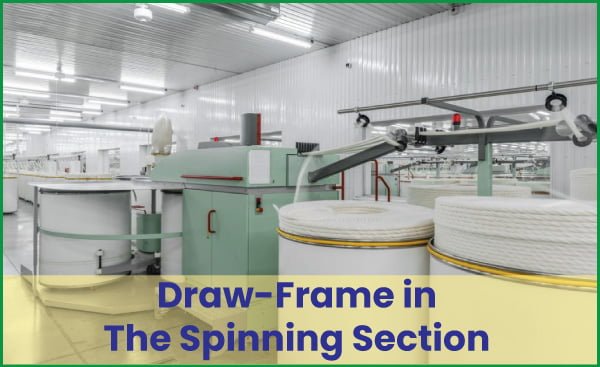Definition, Objects and Necessity of Draw Frame [Spinning]
Last updated on August 10th, 2023 at 07:16 pm
Draw-Frame and Drawing
Carded Slivers are fed into the Draw-Frame and are stretched/ Straightened and made into a single sliver. Also, fibre blending can be done at this stage.
At the drawing stage, the material passes not only one m/c but usually 2, arranged 1 after the other & combined to form a group. Processing in 2 passages is necessary completely to fulfil the requirements. The 2nd passage is often superfluous after combing m/c because then it does not normally generate any improvement in quality.

So we can say that, A process in short-staple spinning in which the sliver is blended, doubled, levelled and drafted by passing the sliver through a series of pair of rollers each pair moving faster than the previous one is called drawing.
The machine by which drawing is accompanied is called draw frame.
Objects of Drawing
- To straighten the crimped and hooked fibres in the card sliver.
- To improve the short medium and long term unevenness of the sliver by doubling.
- To produce a more uniform sliver.
- To achieve a fairly through parallelization of the fibre along the sliver axis.
- To reduce the knot/unit length of card sliver.
- To mix the fibre intimately.
- To make the perfect blend of fibre.
- To remove the dirt, dust from carded sliver.
Necessity of Draw Frame
To parallelization of fibre and blending → Carded sliver
In carded sliver, fibre present in hook form, i,e. Trailing hooks and leading hooks. To parallel those hooks, draw frame is used. Majority of fibre hooks in a carded sliver are trailing form. Whereas leading hooks are comparatively less. Trailing hooks are also known as major hooks, while leading hooks are known as minor hooks.
Definitions of Different Terms of Draw Frame
Doubling
The process of combing two or more sliver roving’s or yarns into one is called doubling. This term is not restricted to the combination of two units only.
Draft
The reduction of weight / yard of sliver and the increase in length is called drafting. Or Attenuation of sliver without breaking is called draft.
Drafting
The process of attenuating or increasing length per unit weight of sliver. It is mainly due to the peripheral speed of the roller.
Requirement of Drafting Arrangement
The drafting arrangement is the heart of draw frame and thus the part which influence the quality. The requirements placed on the drafting arrangement in general is correspondingly high.
- Simple, uncomplicated construction.
- Stable design with the smooth running of the rollers.
- A mode of operation giving a high quality of the product even at high running speed.
- The high degree of flexibility i,e. suitable for all raw materials.
- Optimal control over the movement of fibres during the drafting operations.
- High precision both on operation and adjustment.
- Rapid and simple adjustability of roller spacing and draft levers.
- Ease of maintenance and cleanings.
- Optimal economic design.
You may also like – What is Carding: Definition and Meaning



